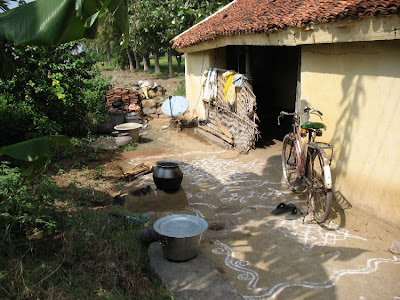The below series of photographs is a pictorial vignette of Arunachala then and now.
Right click on all photographs to view enlarged version.
The first photograph is of an uncluttered Arunachaleswarar Temple taken in 1950.

The next photo is of the Deepam cauldron of about 60 years ago. Previously the cauldron used to remain at the top of Arunachala, but starting from about 70 years ago, the Deepam cauldron only remains on Arunachala during the Festival and when not in use is stored inside the 1000 Pillared Hall at Arunachaleswarar Temple.

The large grounds of the Arts College off Chengam Road (direct south of the Hill), is a favourite spot for lads eager to show off their cricketing skills. On Sundays the whole area is packed with a multitude of cricket matches.

The sides of the roads are popular places for migrant workers from North India to make and sell their Festival statues.

Below one of the very few traffic lights at Tiruvannamalai. Arunachala is nicely in the background.

Visiting the vegetable market off Thiruvoodal Road at the back of Arunachaleswarar Temple. Great spot to buy vegetables and just watch the world go by!

Took the last two photographs specially for this posting. They show Veera Supermarket which is located at the back of Seshadri Ashram (next to Ramana Ashram) off Chengam Road (Girivalam Roadway).
As well as being one of the major supermarkets in the Ramana Nagar area, it also of topical interest now with the current Nithyananda fracas.
Much has been said of Nithyananda hailing from Tiruvannamalai but people nowadays more familiar with his worldwide notoriety -- don't realise of just how much a local lad he was. His father (with house in town) was a merchant in rice and ragi and Veera Supermarket would be a regular customer for deliveries sent by the merchant. And it would be the young schoolboy Nithyananda who would make the deliveries to this and other shops.
At that time he was studying at V.D.S Higher Secondary School in Gandhi Nagar (until the 10th standard), but even though he hailed from town and near the Big Temple, he spent much of his youth at Ramana Nagar. Making deliveries on behalf of his father at the local shops, enjoying the Ramana Ashram library, taking darshan of Yogi Ramsuratkumar, and also working for about a year at the bookshop in Ramana Ashram.


Further to the current Nithyananda fracas, it was announced yesterday that Nithyananda would be giving a press release sometime in the coming days with information about the now infamous videos. More to come.



















































